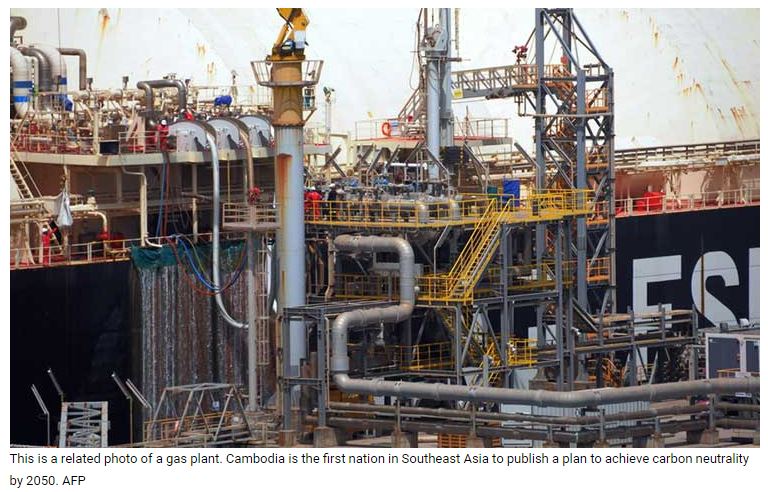Asean’s natural gas demand to double by 2050
The demand for natural gas, a key fuel in the energy transition period to achieve carbon neutrality, will more than double in the Asean region to 350 billion cubic metres by 2050, according to a recent workshop, organised jointly by Economic Research Institute for ASEAN and East Asia (ERIA) and Gas Exporting Country Forum (GECF) in Jakarta.
Several Asean countries including Cambodia, Thailand, Indonesia and Malaysia have announced their carbon neutrality targets. Cambodia was, in fact, the first nation in Southeast Asia to publish a plan to achieve carbon neutrality by 2050 through its roadmap, known officially as a ‘Long-term strategy for Carbon Neutrality (LTS4CN).’
According to Cambodia’s Power Development Plan, prepared by the Ministry of Mines and Energy (MME), the country is expected to generate 3,600MW of power from LNG plants by 2030.
Prof Hidetoshi Nishimura, President of ERIA, is of the view that applying existing and affordable fuels and energy technologies to expand the use of natural gas is one way to reduce greenhouse gas emissions.
That was the gist of the message delivered by him at the workshop on ‘Prospects of a Natural Gas Market in the East Summit (EAS) Region Amidst Carbon Neutrality Pledges and Geopolitical Tensions.’
According to a press release by ERIA, Prof Nishimura said that decarbonising energy systems require the rapid scaling up of existing cleaner energy sources and technologies with essential support for policy, fiscal, and monetary incentives, and appropriate market design.
Eng Mohamed Hamel, GECF’s Secretary General, forecast that in the Asean region, natural gas demand was expected to more than double, rising to more than 350 billion cubic metres by 2050.
The region’s share of natural gas in its energy mix is projected to consistently grow to 24 percent by 2050, he added.
Shigeru Kimura, ERIA’s Special Advisor to the President on Energy, said that natural gas is a key fuel in the energy transition period to achieve carbon neutrality and, with carbon capture and storage (CCS), will remain so until 2050.
Reflecting on the natural gas and LNG market outlook for 2023, Yui Torikata of analytics firm Kpler said the trend shows global LNG supply rising to an estimated 420 million tonnes in 2023, whilst increasing demand in China due to economic reopening and new long-term LNG contracts is expected to be offset by losses in Japan and the Republic of Korea caused by increasingly available nuclear power.
Yusuke Hidaka, Senior Analyst of the Gas Group, the Institute of Energy Economics, Japan, said that to secure LNG in the medium to long term, investment is crucial in LNG production projects as trade in LNG and natural gas is expected to increase to 430 million tons in 2023.
Tetsuya Watanabe, Special Advisor to the President of ERIA, listed strategies to help the region meet its energy demand and strengthen its export positions in the global gas market whilst gaining the necessary funding — exploit not only conventional natural gas sources but also unconventional resources, have timely and well-planned investment strategies in the natural gas supply chain, and introduce environmentally sound technologies and techniques in projects.
According to Natharoun Ngo Son, Country Director of EnergyLab Cambodia, LNG is a needed fossil fuel to help accelerate Cambodia’s energy transition.
At the opposite of coal, LNG will support the integration of more Variable Renewable Energy (VRE) into Cambodia’s grid, as it allows power flexibility (rapid start-up and shutdown time), he said. But, he was quick to add that LNG should not be used as a single source of energy power to replace coal.
“Cambodia needs to start utilising its knowledge related to the feasibility of increasing solar PV as a clean energy source, in case the new unbuilt coal-fired power plants do not materialise as planned,” Natharoun told Khmer Times yesterday.
“It needs to plan for more solar, and calculate the amount that would be coming in replacement of unbuilt coal. Then it should plan for the right amount of LNG power to balance the variability of solar energy,” he said.
According to Natharoun, the country should not lock in more LNG than it needs, as otherwise it would decrease the space for clean energy, and delay further the clean energy transition. “LNG must be used wisely as a means for Cambodia to adopt more clean energy,” he said.
Source: https://www.khmertimeskh.com/501250929/aseans-natural-gas-demand-to-double-by-2050/


 English
English




